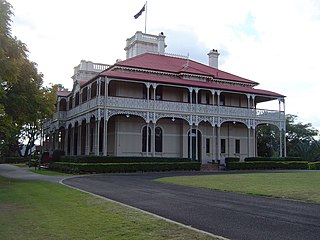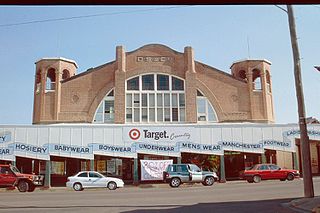
Charters Towers is a rural town in the Charters Towers Region, Queensland, Australia. It is 136 km (85 mi) by road south-west from Townsville on the Flinders Highway. During the last quarter of the 19th century, the town boomed as the rich gold deposits under the city were developed. After becoming uneconomical in the 20th century, profitable mining operations have commenced once again. In the 2016 census, Charters Towers had a population of 8,120 people.

St Mark's Anglican Church is a heritage-listed church at 55 Albion Street, Warwick, Southern Downs Region, Queensland, Australia. It is the second church of that name on that site. It was designed by Richard George Suter and built in 1868 by John McCulloch. It was added to the Queensland Heritage Register on 21 October 1992.

St Agnes Anglican Church is a heritage-listed churchyard at Ipswich Street, Esk, Somerset Region, Queensland, Australia. It was designed by John Hingeston Buckeridge and built in 1889 by Lars Andersen. It is also known as St Agnes Rectory and Church Hall. It was added to the Queensland Heritage Register on 21 October 1992.

Mount Carmel Convent is a heritage-listed Roman Catholic former convent at 199 Bay Terrace, Wynnum, City of Brisbane, Queensland, Australia. It was designed by Hall & Dods and built in 1915 by William Richard Juster. It was added to the Queensland Heritage Register on 27 August 1999.

St Patrick's Church is a heritage-listed Roman Catholic church at 58 Morgan Street, Fortitude Valley, City of Brisbane, Queensland, Australia. It was designed by Andrea Giovanni Stombuco and built from 1880 to 1882 by John Arthur Manis O'Keefe. It was added to the Queensland Heritage Register on 21 October 1992.

Sacred Heart Cathedral is a heritage-listed Roman Catholic cathedral at 266 Stanley Street, Townsville CBD, City of Townsville, Queensland, Australia. It was built from 1896 to 1902 by Dennis Kelleher. It is also known as Church of the Sacred Heart. It was added to the Queensland Heritage Register on 21 October 1992.

Woodlands is a heritage-listed mansion at Seminary Road, Marburg, City of Ipswich, Queensland, Australia. It was designed by George Brockwell Gill and built from 1889 to 1940s. It is also known as Marburg Campus, Ipswich Grammar School and St Vincent's Seminary. It was added to the Queensland Heritage Register on 21 October 1992.

St Paul's Anglican Church is a heritage-listed church at 124 Brisbane Street, Ipswich, City of Ipswich, Queensland, Australia. It was built from 1855 to 1929. It was added to the Queensland Heritage Register on 21 October 1992.

St Mary's Church and Convent are heritage-listed Roman Catholic church buildings at 34 Ingham Road, West End, City of Townsville, Queensland, Australia. It was designed by the Rooney Brothers and built by Cowell & Holt in 1888. It was added to the Queensland Heritage Register on 2 January 1993.

Charters Towers Masonic Lodge is a heritage-listed masonic temple at 20 Ryan Street, Charters Towers City, Charters Towers, Charters Towers Region, Queensland, Australia. It was built from 1887 to 1897. It was added to the Queensland Heritage Register on 21 October 1992.

St Brigid's Church is a heritage-listed Roman Catholic church at 523 Stuart Drive, Stuart, City of Townsville, Queensland, Australia. It was built in 1904. It was added to the Queensland Heritage Register on 21 October 1992.

Pfeiffer House is a heritage-listed detached house at 2–6 Paull Street, Charters Towers City, Charters Towers, Charters Towers Region, Queensland, Australia. It was built c. 1881. It is also known as Church of Jesus Christ of Latter Day Saints and Day Dawn House. It was added to the Queensland Heritage Register on 21 October 1992.

Bank of New South Wales is a heritage-listed former bank building at 34–36 Gill Street, Charters Towers City, Charters Towers, Charters Towers Region, Queensland, Australia. It was designed by Eyre & Munro and built in 1889 by Kelleher. It is also known as Wherry House. It was added to the Queensland Heritage Register on 9 November 2012.

Aldborough is a heritage-listed villa at 25 Deane Street, Charters Towers City, Charters Towers, Charters Towers Region, Queensland, Australia. It was designed by William Henry Allan Munro and built in 1900 by Thomas Barry O'Meara. It was added to the Queensland Heritage Register on 14 August 2008.

Church of Christ is a heritage-listed church at Anne Street, Charters Towers City, Charters Towers, Charters Towers Region, Queensland, Australia. It was built from 1885 to 1887. It is also known as St Johannes Lutheran Church and The "German Church". It was added to the Queensland Heritage Register on 28 May 1999.

Charters Towers City is the central suburb and central business district of the town of Charters Towers in the Charters Towers Region, Queensland, Australia. In the 2016 census, Charters Towers City had a population of 2,134 people.

Pollard's Store is a heritage-listed department store at 18 Gill Street, Charters Towers City, Charters Towers, Charters Towers Region, Queensland, Australia. It was built from c. 1909 to 1930s. It was also known as Daking-Smith & Company and Fossey's Store. It was a Target Country store until it was converted to the K Hub format in 2021. It was added to the Queensland Heritage Register on 3 October 1996.

St Columba's Convent is a heritage-listed Roman Catholic former convent at 169 Cunningham Street, Dalby, Western Downs Region, Queensland, Australia. It was designed by George Bernard Roskell and built in 1913 by John Draney. It is also known as Iona. It was added to the Queensland Heritage Register on 9 December 2010.

Charters Towers Post Office is a heritage-listed post office at 17 Gill Street, Charters Towers City, Charters Towers, Charters Towers Region, Queensland, Australia. It was added to the Australian Commonwealth Heritage List on 8 November 2011.

Queensland National Bank is a heritage-listed former bank building at 72 Mosman Street, Charters Towers City, Charters Towers, Charters Towers Region, Queensland, Australia. It was designed by Francis Drummond Greville Stanley and built from 1891 to 1949. It is also known as the Charters Towers' City Hall. It was added to the Queensland Heritage Register on 26 June 2020.























